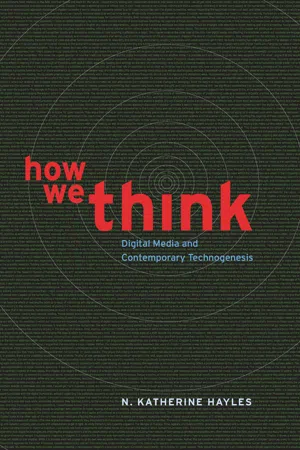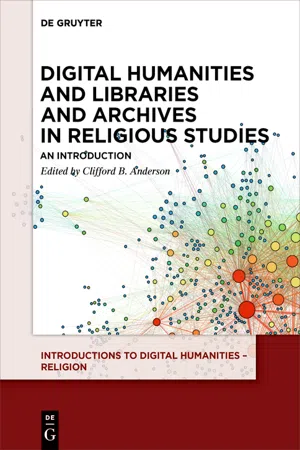Digital Humanities
Digital Humanities is an interdisciplinary field that applies computational methods and tools to the study of literature and other cultural artifacts. It involves the use of digital technologies to analyze, interpret, and present literary texts and related materials. Digital Humanities scholars often collaborate across disciplines to explore new ways of understanding and engaging with literature in the digital age.
6 Key excerpts on "Digital Humanities"
- eBook - ePub
- Melinda A. Cro(Author)
- 2020(Publication Date)
- Georgetown University Press(Publisher)
...1 The Digital Humanities: Definitions and Debates T HE HUMANITIES HAVE undergone a shift recently, wherein scholars seek to take advantage of the advent of new and increasingly accessible forms of technology to facilitate the collection and analysis of big data. Tom Scheinfeldt has likened these new technological approaches in the humanities in which information is evaluated in new and unanticipated ways to the desire of late nineteenth- and early twentieth-century scholars to catalog the expanding range of information made available through advents in technology and science (P. Cohen 2010). Other scholars see the move from print to digital as analogous to the “flowering of Renaissance and post-Renaissance print culture” (Burdick et al. 2012). Notwithstanding the numerous articles and entries proposing to define the Digital Humanities, a clear and concise definition remains elusive, in part due to conflation regarding the purpose and nature of the practice itself. This chapter proposes an understanding of the Digital Humanities as a transdisciplinary or interdisciplinary endeavor characterized by a specific methodology that is particularly well suited for adaptation and use in the second language classroom. Background The Digital Humanities, as a practice of humanistic endeavor, is far older than one might assume given the current hype surrounding the field. The origins of what is today classified as the Digital Humanities may be traced to an early computing project undertaken by an Italian Jesuit priest, Roberto Busa, who, in 1949, embarked on an effort to create a concordance of St. Thomas Aquinas and related authors’ works. The total was around 11 million words of medieval Latin. Busa hypothesized that a machine might facilitate the process and reached out to IBM for support...
- eBook - ePub
The Digital Humanities Coursebook
An Introduction to Digital Methods for Research and Scholarship
- Johanna Drucker(Author)
- 2021(Publication Date)
- Routledge(Publisher)
...Thus the digital humanist continues the work of reading, studying, reflecting, and arguing while making use of tools and platforms whose techniques might not be apparent. Making some of those techniques legible is part of the learning process and should also be part of the documentation that accompanies research. Other debates about the fundamental politics of doing digital work arise from within critical race studies, where links between the larger contexts of digitization and long term practices of exclusion and oppression call for attention (Risam 2015). Other critics have suggested that Digital Humanities is intimately connected to the policies of entrepreneurial neo-liberalism within higher education. Questions of gendered asymmetries in practice and institutional roles, concerns about credit for intellectual labor, and discussions of marginalization and challenges to enfranchisement, have been raised usefully at micro and macro levels of production. The course book approach This book is structured as a course in Digital Humanities. It begins with basics in every topic to explore the fundamental components of all digital projects. Implementations of these components, and decisions made at the outset, have implications for the longevity and sustainability of projects and research. The course begins with data production and use, file formats, and markup languages. Then it addresses standards for metadata and description or classification, activity that puts Digital Humanities in dialogue with libraries, museums, archives, and cultural memory practices. After that, it examines ways of working with data in visualizations, mapping, networks, and other diagrams. Other chapters look at text analysis, data mining, and tools of interpretation at the close and distant reading scales (including topic modeling). In shifting towards narrative and presentation, it focuses on interface design and user experience...
- eBook - ePub
How We Think
Digital Media and Contemporary Technogenesis
- N. Katherine Hayles(Author)
- 2012(Publication Date)
- University of Chicago Press(Publisher)
...This perspective is in line with that adopted by the NEH Office of Digital Humanities (Bobley, Rhody, and Serventi, 2011), whose personnel were advised at the program’s birth to define the Digital Humanities as broadly as possible. For my purposes, the Digital Humanities include, among other kinds of projects, text encoding and analysis, digital editions of print works, historical research that recreates classical architecture in virtual reality formats such as Rome Reborn and The Theater of Pompey, archival and geospatial sites, and, since there is a vibrant conversation between scholarly and creative work in this field, electronic literature and digital art that draws on or remediates humanities traditions. Scale Matters Perhaps the single most important issue in effecting transformation is scale. Gregory Crane (2008a) estimates that the upward bound for the number of books anyone can read in a lifetime is twenty-five thousand (assuming one reads a book a day from age fifteen to eighty-five). By contrast, digitized texts that can be searched, analyzed, and correlated by machine algorithms number in the hundreds of thousands (now, with Google Books, a million and more), limited only by ever-increasing processor speed and memory storage. Consequently, machine queries allow questions that would simply be impossible by hand calculation. Timothy Lenoir and Eric Gianella (2011), for example, have devised algorithms to search patents on radio frequency identification (RFID) tags embedded in databases containing six million five hundred thousand patents...
- eBook - ePub
- Raman Selden, Peter Widdowson, Peter Brooker(Authors)
- 2016(Publication Date)
- Routledge(Publisher)
...The study of world literature therefore presents a series of new issues, by turns, exhilarating and problematic. Of these, both Moretti and Damrosch point to perhaps the primary, underlying question: less the scale of production or rhythms of circulation, or ‘what to read’ so much as ‘how to read’ world literature. To this extent, Damrosch’s guidance and illustrative case studies of pairs of texts, across modes and genres, times and cultures, and in translation, makes his How to Read World Literature (2009) a particularly instructive, if challenging, model. Digital Humanities Digital Humanities, of which digital Literary Studies is a constituent part, had its beginnings, on one side, in mid-twentieth century computer studies and has come to prominence in an alliance with Humanities disciplines in the wake of the DOT COM bubble (triggered by high investment in new internet companies) in the 1990s and subsequently, the ubiquity of personal computers, the accelerated generation of software, and the advent of ‘smart’ phones, ipads, apps and other platforms. At the locus of the ‘disturbance’ registered in this case in academic, intellectual and artistic life are the house-hold names, across the globe, of Google, Amazon, and Facebook: engines of unprecedented access to information, vehicles of consumption and instant communication – and enormous wealth. The world made digital is a facet, an enabling facet, of globalisation, whose home, for all its global reach, is in the West. Johanna Drucker writes how digital methods seemed initially to endorse and make real the insights of Derrida and Deleuze and Guattari: ‘Literary scholars influenced by deconstruction saw in digital texts a condition of mutability than seemed to put the idea of differential “play” into practice … Suddenly it seemed that conventions of “linearity” were being exploded … Rhizomatic networks undercut the apparent stasis of the printed page. Texts seemed fluid, mobile, dynamically charged’ (SpecLab, 2009)...
- eBook - ePub
- Clifford B. Anderson, Clifford B. Anderson(Authors)
- 2022(Publication Date)
- De Gruyter(Publisher)
...Indicative of this interest are the recurring presentations about the Digital Humanities at Atla annual meetings and webinars. 2 As theological schools prepare students for careers in the church and social ministries, is there a way to provide them with a humanistic and theological perspective on our increasingly computational and algorithmically-driven society? The COVID-19 pandemic has reinforced the need for understanding of the digital world, as pastors seek to communicate with their congregations using tools like Zoom, Facebook, and the Adobe Creative Cloud, and as they worry about the distorting effects of filter bubbles, echo chambers, and the digital divide on their church members. The teaching of Digital Humanities at theological institutions raises distinct challenges, however. At university-based divinity schools, students and faculty may discover like-minded colleagues at Digital Humanities centers or digital scholarship labs. But the staff members in these digital scholarship units may not have expertise in religious studies or theology. At independent theological schools, by contrast, the task of teaching Digital Humanities may fall to intrepid faculty or librarians who, having taught themselves, have learned enough to offer workshops or experimental courses in Digital Humanities. We argue that the best way to prepare students for ministry in an increasingly computational context is to teach the fundamentals of computational thinking and algorithmic literacy rather than specific tools and techniques, which arise and fade away at an accelerating pace. We believe that theological librarians may learn from the innovators of the Beauty and Joy of Computing (https://bjc.berkeley.edu/) curriculum about how to provide these foundations to students, either in collaboration with faculty or as co-curricular library instruction in digital literacy...
- Kristen Schuster, Stuart Dunn, Kristen Schuster, Stuart Dunn(Authors)
- 2020(Publication Date)
- Routledge(Publisher)
...DH is a coming together of “the Digital”, a field comprised of its own traditions of new media, science and technology studies, information science and so on; and “the Humanities”, a collective intellectual term with all its problematic epistemological complexity. Like many who have gone before us, we choose not to directly tackle the question “what is DH”. There is a plethora of differing schools of thought that would take issue with any definition we might venture; however approaching the question in the framework of a methodological handbook—rather than a research anthology—allows us to consider it as one of method and methodology (more on the distinction between those two words below), rather than one of abstract nomenclature. This allows us to particularize based on what scholars across both “the Digital” and “the Humanities” actually do in their day-to-day practice, and how that practice combines the role of both humans and machines (and media). Articulating the ways in which the symbiotic knowledge systems which result are formed enables us to characterize the concept of a research method as a formalized way of doing things, drawing on multiple perspectives, but expressed in a shared language. Collaboration: Problems and opportunities (or a problematic opportunity) The argument that DH has a particular methodology or research method is not new. There is a plethora of conference proceedings (e.g. ACM Symposium on Document Engineering), edited volumes and special journal issues, such as Debates in the Digital Humanities, and email lists like SHARP-L, Cambridge Digital Humanities and the Humanist that explain, debate and analyse what DH is, and what DH methods are (or should be). Among all of these opinions and projects, there is a consensus that DH is interdisciplinary and collaborative. However, something is missing from this deluge of opinions, arguments and theories...





